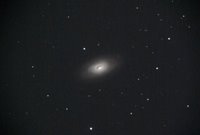The meeting was a pretty good one. Gerry Somolyk, gave a Powerpoint presentation on his trip to Turkey, which took place on Wednesday, March 29th 2006, to see a total eclipse of the Sun that was visible from within a narrow corridor that traverses half the Earth. The path of the Moon's umbral shadow began in Brazil and extended acrossed the Atlantic, northern Africa, and central Asia where it ended at sunset in western Mongolia. A partial eclipse was seen within the much broader path of the Moon's penumbral shadow, which included the northern two thirds of Africa, Europe, and central Asia. For more information about this event, click here.
 Image courtesy of NASA
Image courtesy of NASAHere is video I took of the Society grounds prior to new member orientation:
During the meeting of the board, between and 7:30 pm and 8:00 pm, there is an opportunity for new members to learn basics of astronomy as taught by a senior member of the club. Since I have joined the club, Bob Manske has handled the orientation. New members usually meet in the Z Dome for these sessions. The Z Dome is the largest of the domes on the Society grounds.
Here are a couple of videos of the inside of the dome, one before the orientation started, and one just as it's about to end.
During the meeting of the board, between and 7:30 pm and 8:00 pm, there is an opportunity for new members to learn basics of astronomy as taught by a senior member of the club. Since I have joined the club, Bob Manske has handled the orientation. New members usually meet in the Z Dome for these sessions. The Z Dome is the largest of the domes on the Society grounds.
Here are a couple of videos of the inside of the dome, one before the orientation started, and one just as it's about to end.
Inside the Z Dome - Part I
Inside the Z Dome - Part II
After the meeting, Jordan ran to Burger King to get something quick to eat, but were disappointed to find it closed. So we had to settle for Taco Bell. We came back to do some star gazing.
We got to see Jupiter and Saturn, which thrilled Jordan, Tristan and Caleb.
I also spent some time in the building below the Z Dome using the CCD. Neil was at the helm and he found globular clusters M3 and M5 along with the Black Eye Constellation.
 Messier 3 is one of the most outstanding globular clusters, containing an estimated half million stars. It is famous for the large number of variable stars discovered in it.
Messier 3 is one of the most outstanding globular clusters, containing an estimated half million stars. It is famous for the large number of variable stars discovered in it.


No comments:
Post a Comment